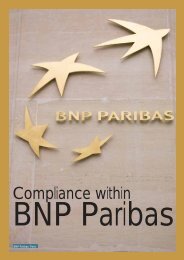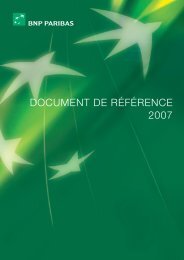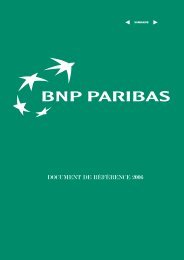2007 REGISTRATION DOCUMENT
2007 REGISTRATION DOCUMENT
2007 REGISTRATION DOCUMENT
- No tags were found...
You also want an ePaper? Increase the reach of your titles
YUMPU automatically turns print PDFs into web optimized ePapers that Google loves.
5 NotesCONSOLIDATED FINANCIAL STATEMENTSto the financial s tatements p repared in accordance with I nternational Financial Reporting S tandards as adopted by the European Union1.h.2Long-term benefitsThese are benefits (other than post-employment benefits and terminationbenefits) which do not fall wholly due within twelve months after theend of the period in which the employees render the associated service.This relates in particular to compensation deferred for more than twelvemonths, which is accrued in the financial statements for the period inwhich it is earned.The actuarial techniques used are similar to those used for definedbenefitpost-employment benefits, except that actuarial gains and lossesare recognised immediately and no “corridor” is applied. The effect of anyplan amendments regarded as relating to past service is also recognisedimmediately.1.h.3Termination benefitsTermination benefits are employee benefits payable as a result of adecision by the Group to terminate a contract of employment before thelegal retirement age or a decision by an employee to accept voluntaryredundancy in exchange for a benefit. Termination benefits falling duemore than twelve months after the balance sheet date are discounted.1.h.4Post-employment benefitsIn accordance with IFRS, the BNP Paribas Group draws a distinctionbetween defined-contribution plans and defined-benefit plans.Defined-contribution plans do not give rise to an obligation for the Groupand consequently do not require a provision. The amount of employer’scontributions payable during the period is recognised as an expense.Only defined-benefit schemes give rise to an obligation for the Group.This obligation must be measured and recognised as a liability by meansof a provision.The classification of plans into these two categories is based on theeconomic substance of the plan, which is reviewed to determine whetherthe Group has a legal or constructive obligation to pay the agreedbenefits to employees.Post-employment benefit obligations under defined-benefit plans aremeasured using actuarial techniques that take account of demographicand financial assumptions.The amount of the obligation recognised as a liability is measured onthe basis of the actuarial assumptions applied by the Group, using theprojected unit credit method. This method takes account of variousparameters such as demographic assumptions, the probability thatemployees will leave before retirement age, salary inflation, a discountrate, and the general inflation rate. The value of any plan assets isdeducted from the amount of the obligation.Where the value of the plan assets exceeds the amount of the obligation,an asset is recognised if it represents a future economic benefit for theGroup in the form of a reduction in future contributions or a futurepartial refund of amounts paid into the plan.The amount of the obligation under a plan, and the value of the planassets, may show significant fluctuations from one period to the nextdue to changes in actuarial assumptions, thereby giving rise to actuarialgains and losses. The Group applies the “corridor” method in accountingfor actuarial gains and losses. Under this method, the Group is allowed torecognise, as from the following period and over the average remainingservice lives of employees, only that portion of actuarial gains and lossesthat exceeds the greater of (i) 10% of the present value of the grossdefined-benefit obligation or (ii) 10% of the fair value of plan assets atthe end of the previous period.At the date of first-time adoption, BNP Paribas elected for the exemptionallowed under IFRS 1, under which all unamortised actuarial gains andlosses at 1 January 2004 are recognised as a deduction from equity atthat date.The effects of plan amendments on past service cost are recognised inprofit or loss over the full vesting period of the amended benefits.The annual expense recognised in the profit and loss account under“Salaries and employee benefits” in respect of defined-benefit planscomprises the current service cost (the rights vested in each employeeduring the period in return for service rendered), interest cost (theeffect of discounting the obligation), the expected return on planassets, amortisation of actuarial gains and losses and past service costarising from plan amendments, and the effect of any plan curtailmentsor settlements.1.i SHARE-BASED PAYMENTShare-based payment transactions are payments based on sharesissued by the Group, whether the transaction is settled in the formof equity or cash of which the amount is based on trends in thevalue of BNP Paribas shares.IFRS 2 requires share-based payments granted after 7 November2002 to be recognised as an expense. The amount recognised is thevalue of the share-based payment made to the employee.The Group grants stock subscription option plans and deferredshare-based compensation plans to employees, and also offersthem the possibility of subscribing for specially-issued BNP Paribasshares at a discount on condition that they retain the shares fora specified period.1.i.1Stock option plans< Contents >The expense related to stock option plans is recognised at the dateof grant if the grantee immediately acquires rights to the shares,or over the vesting period if the benefit is conditional upon thegrantee’s continued employment. Stock option expense is recordedin salaries and employee benefits, and its credit entry is posted toshareholders’ equity. It is calculated on the basis of the overall planvalue, determined at the date of grant by the Board of Directors.In the absence of any market for these instruments, mathematicalvaluation models are used. The total expense of a plan is determinedby multiplying the unit value per option by the estimated number ofoptions that will vest at the end of the vesting period, taking accountof conditions regarding the grantee’s continued employment.The only assumptions revised during the vesting period, and henceresulting in a remeasurement of the expense, are those relatingto the probability that employees will leave the Group and thoserelating to performance conditions that are not linked to the valueof BNP Paribas shares.1234567891011126<strong>2007</strong> Registration document - BNP PARIBAS
















